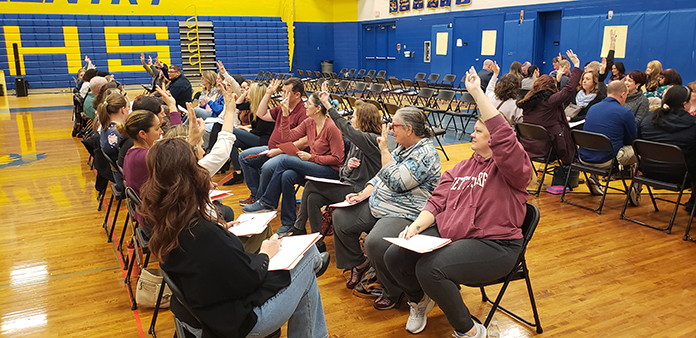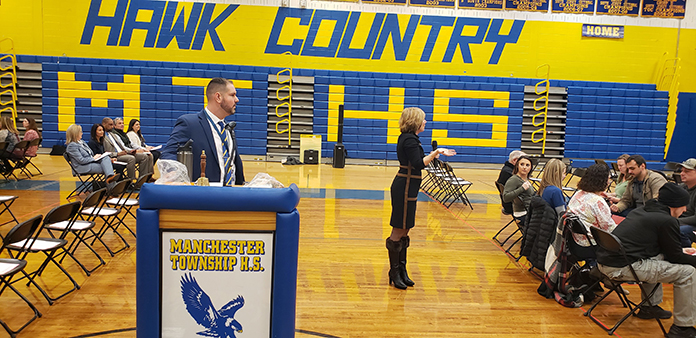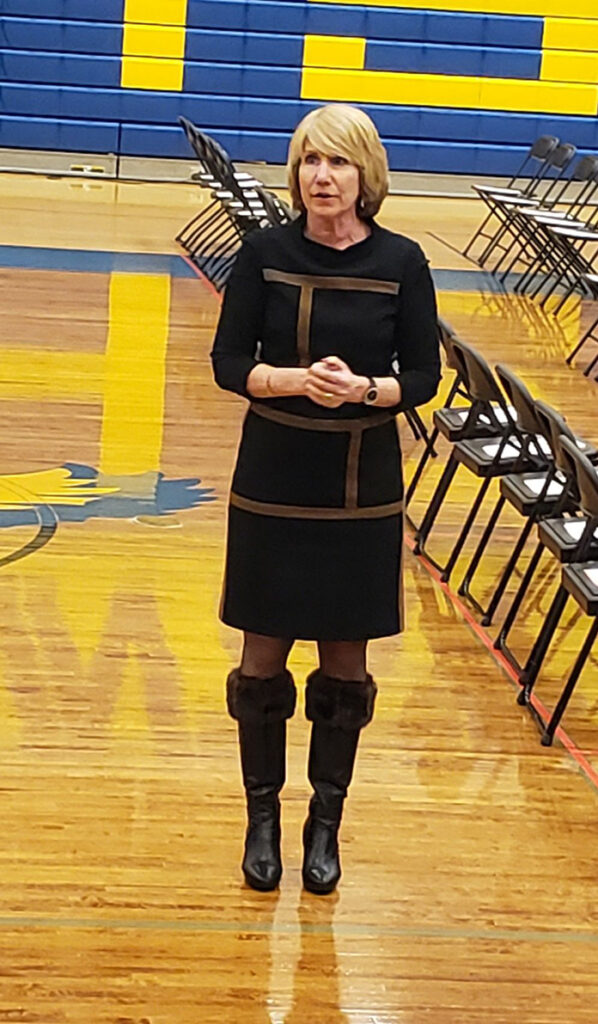
MANCHESTER – The gymnasium bleachers at the township high school were nearly filled but the crowd wasn’t there to cheer on the Hawks but to provide input toward the school district’s future.
School officials want to know what parents and the public see in that future and they are designing a Strategic Plan that will guide the Board of Education to develop goals and strategies to achieve educational success for the school district. The Strategic Planning Event was one part of that.
The district partnered with Dr. Tracey Severns of Teach4Results to facilitate the school district’s Strategic Planning process. Dr. Severns provided an interactive, transparent approach in which inviting all stakeholders of the school community to contribute.
Severns is “a nationally renowned educator who has dedicated her career to students, teachers, administrators and school communities.” She has served as a teacher, principal, superintendent, Chief Academic Officer for the New Jersey Department of Education, the Leadership and Learning Strategist for Rutgers School of Education’s Center for Effective School Practices, and host of DisruptED TV.

Superintendent John Berenato explained that Dr. Severns’ Strategic Improvement Plans use research-based strategies to achieve data-driven goals. “The strategic planning process is an opportunity for school and community stakeholders to look forward by identifying the district’s strengths, weaknesses, target issues and then develop and prioritize annual goals that achieve district success.
“The Strategic Planning events are an opportunity for all students, staff, parents and residents to provide the school district with their feedback. We provide students with services and they too will have the opportunity during their own strategic planning sessions to elevate their voices in the same way the staff, families and community will,” Berenato added. “By working together in this way, strategic planning will help the district to forecast and prioritize our district’s specific needs and then develop strategies that support these needs. We hope to have a large turnout and participation from all.”
The data that was collected by Dr. Severns from the recent Strategic Planning event will be analyzed and those results will be presented to members of the Board of Education at their June public meeting. The Board will then come together with the school administration to lay out the goals and how to achieve those goals.
Among those present to take part in the hour-long interactive survey activity were Mayor Robert Arace and Council members Roxy Conniff, James Vaccaro and Michele Zolezi. Teachers and staff already completed the survey, according to Berenato.
“After the activity is completed we will poll the entire community just to get some additional thoughts from other people. Dr. Severns will then analyze the data from all the stakeholders which includes the staff, students and everyone who is here tonight. This information will be shared at a Board of Education meeting at a public session. We are hoping to do that at our June meeting,” the superintendent added.
Berenato said, “I want to assure you that we value your input and we do not expect any major changes for this coming September. The information we get tonight will help us in developing changes for the subsequent school year.”
The crowd moved from the bleachers to chairs positioned for attendees to sit across from each other to converse. Dr. Severns addressed them: “Tonight we will be engaging in a practice that looks a lot like speed dating. It won’t be like that all actually but we are going to involve everyone in a conversation to hear your ideas, your input and insight to help guide decisions to bring Manchester forward.”
“I have been to all of the (Manchester) schools and have met with representative groups of students grades 3 to 12 and I asked them to give us ideas and input on a few things. Ways to bring a stronger sense of community to schools. I have a list of ideas and there are other ideas they shared about how they like to learn, what they like to learn and the way the school experience has served them,” Severns added.

“I had about 30 students in each of the schools and I brought all of that information with me. I will compile that to see what the kids are saying. With the faculty and all of the staff we had an activity using these same questions in exactly the same manner,” she said.
There were five questions listed on each chair for the attendees that night at the high school. They were the same five questions and “that was done by design because we want everyone to be able to answer each question,” Severns said.
The questions included what the person saw as the strengths of the district, what the district was proud of, opportunities to improve, “and the space between what is and what we possibly could be. The third question is about opportunities and multiple resources. This community has many resources that have to be tapped to help support the school system.”
The fourth question Severns said was about internal threats – things inherent in the school district such as facilities as an issue, morale as an issue, if attracting and retaining staff is an issue.
The fifth question “is about external threats. These are things that are in the political landscape, state funding, state mandates, changes in the community that you cannot necessarily control. Things that happen outside the school walls but that can impact what happens in the school walls,” Severns added.
She stressed that the process would have full transparency and all that is learned would be shared “for everyone to see and hear.”






